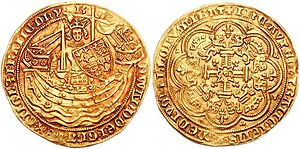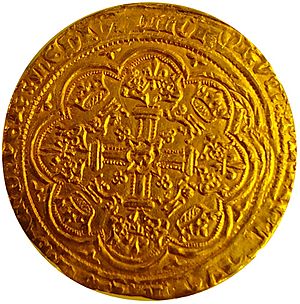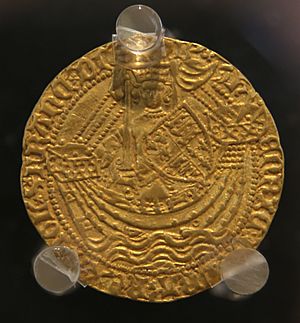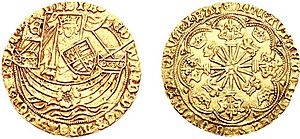Noble (English coin) facts for kids

The noble was the first important English gold coin that was made in large numbers. It was first created during the reign of King Edward III between 1344 and 1346. Before the noble, there were other gold coins like the gold penny and the florin, but they were not used very much. The noble's smaller versions, the half noble and quarter noble, were very popular.
This coin was worth six shillings and eight pence (written as 6/8). This was the same as eighty old pence, or one-third of a pound sterling. The coin's weight changed over time to keep its value the same. However, in 1464, its value was increased. Over the years, nobles had many different designs, words, and mint marks (small symbols showing where they were made).
Contents
How the Noble Coin Started
The noble coin was first made during King Edward III's second period of coinage (1344–1346). At that time, it weighed about 9.0 grams. Later, during his third period (1346–1351), its weight was reduced to about 8.3 grams. In his fourth period (1351–1377), it became even lighter, weighing about 7.8 grams. The noble coin was about 33–35 mm wide. The half noble was 25–26 mm, and the quarter noble was 19–21 mm.
What the Noble Looked Like
On the front side of the coin, it showed King Edward III holding a sword and a shield while standing in a ship. The words around him said, "Edward by the grace of God King of England and France Lord of Ireland."
On the back side, there was a cross with the letter 'L' in the middle. The words on this side said, "But Jesus passing through their midst went His way." The picture of the ship and these words from the Bible (from the Gospel of Luke) were put on the coin to remember Edward's big victory at the Battle of Sluys in 1340.
For the third period of coinage, the design was mostly the same. The only change was that the letter in the middle of the cross on the back became an 'E' instead of an 'L'.
During the fourth period of coinage, the words on the coins changed because of politics. At first, Edward still claimed to be the King of France. But after a peace agreement called the Treaty of Brétigny in 1360, he dropped that claim. So, the coins then said he was the Lord of Aquitaine instead. In 1369, the treaty broke down, and he claimed the French throne again.
Nobles from 1377 Onwards

During the time of King Richard II (1377–1399), noble coins were made in both London and Calais (a city in France that England controlled). Coins made in Calais are special because they have a small flag on the back of the ship. These coins are quite rare today.
The words on the front of Richard II's coins usually said, "Richard by the grace of God King of England and France Lord of Ireland and Aquitaine." The words on the back were the same as before: "But Jesus passing through their midst went His way."
Nobles made during the reign of King Henry IV (1399–1413) come in two types. The "Heavy Coinage" nobles were made until 1412 and weighed about 7.8 grams. The "Light Coinage" nobles were made in 1412–1413 and weighed about 7.0 grams. It can be tricky to tell Henry IV's nobles apart from those made by King Henry V and King Henry VI because they look very similar. Experts look at small details like the mintmarks to tell them apart.
During the Heavy Coinage period, nobles were made in London and Calais. Again, the Calais coins had a flag on the ship. During the Light Coinage period, nobles were only made in London.
The words on Henry IV's coins usually said, "Henry by the grace of God King of England and France Lord of Ireland and Aquitaine." The back of the coin had the same religious phrase.
Nobles from 1413 Onwards

The coins of Henry V (1413–1422) look very much like his father's coins. However, there are about seven different styles of design and lettering. One way to tell them apart is that Henry V's coins often left out the "and Aquitaine" part of the title.
The words on Henry V's coins usually said, "Henry by the grace of God King of England and France Lord of the Irish." The back of the coin had the same religious phrase.
Nobles were also made throughout Henry VI's first time as king (1422–1461). However, there was a shortage of gold, so fewer coins were made. Coins were made in both London and Calais for a while, but towards the end of this period, they were only made in London.
The words on Henry VI's coins were similar: "Henry by the grace of God King of England and France Lord of the Irish." The back of the coin also had the same religious phrase.
In a TV show called Time Team, a gold Noble coin was found while digging at Codnor Castle. This discovery helped historians figure out when the castle was built. It also suggested that people from the castle might have fought in the famous Battle of Agincourt.
The Noble's Final Years
| Edward IV: Ryal | |
|---|---|
 |
|
| Edward standing facing, holding sword and shield, in ship, E on banner at stern, rose on hull, quatrefoil of four pellets after FRAnC, pellet to lower left of shield | Rose over sun with fleurs, crowns, and lions; small trefoils in spandrels; quatrefoil of four pellets after ILLORVM, first S missing in TRAnSIEnS |
| AV Ryal Rose Noble (7.59 g, 12h). Light coinage, Type VIII, 1467–1468. London mint, mintmark: -/crown | |
The gold noble coin, which had not changed much since King Edward III's time, was made for the last time during the first reign of King Edward IV (1461–1470). From the 1430s onwards, the price of gold went up. This meant that gold coins were worth more in other parts of Europe than in England. Because of this, many gold coins were sent out of England to make a profit, causing a gold shortage.
Only a small number of nobles were made during Edward IV's Heavy Coinage period (1461–1464) in London. Finally, in 1464, to stop coins from leaving the country, the value of all gold nobles was increased. They went from being worth six shillings and eight pence (6/8) to eight shillings and four pence (8/4).
A new coin called the "Rose Noble" or "Royal" was also introduced. It was worth ten shillings and weighed about 7.8 grams. However, this new coin was not very popular and was stopped after 1470. Instead, a different new coin called the angel was introduced in 1464. It was worth six shillings and eight pence, just like the original noble, and quickly became a very popular and important coin.
The words on Edward IV's coins usually said, "Edward by the grace of God King of England and France Lord of Ireland." The back of the coin had the same religious phrase.
The value of six shillings and eight pence (6/8) was used in accounting in Britain for a very long time, even up until 1971 when the currency changed to a decimal system.
The Noble in Shakespeare's Plays
The noble coin is mentioned in several plays by Shakespeare. This shows how common and well-known the coin was in those times.
- Henry IV, Part 1
- Hostess: My lord, there is a nobleman at the door who wants to speak with you. He says he comes from your father.
- Prince Henry: Give him enough money to make him a royal man, and send him back to my mother.
- Here, the word royal refers to the new noble coin, which was worth 10 shillings.
- Henry VI, Part 1
- Shepard: It's true, I gave a noble to the priest the morning I married her mother.
- Henry V
- Nym: Will I get my eight shillings that I won from you in betting?
- Pistol: You shall have a noble, and you'll get paid right now;
- Richard III
- Gloucester: ...
- That just two days ago, were hardly worth a noble.
- Much Ado About Nothing
- Benedick: ...noble, or not I for an angel;...
See also

